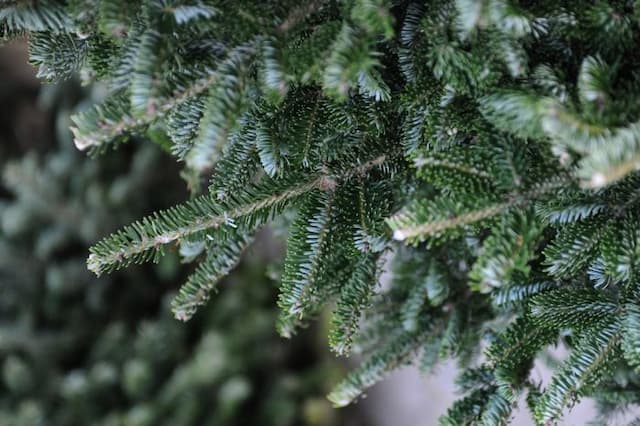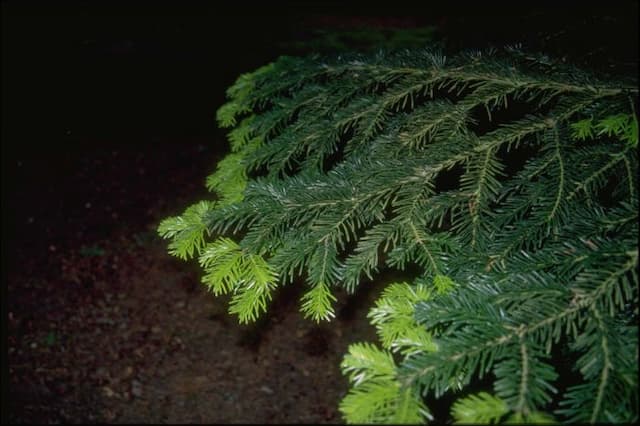Ponderosa Pine Pinus ponderosa

ABOUT
The Pinus ponderosa, commonly known as the ponderosa pine, is a coniferous tree with a distinct appearance. Its bark is a noteworthy feature, being thick, rugged, and puzzle-like with a rich cinnamon-brown to blackish color that helps protect the tree from fires. The bark texture changes with age, becoming more plated and furrowed as the tree matures. The needles of the ponderosa pine are long, slender, and typically found in bundles of three, sometimes two or five, with a deep green hue that adds to the tree's lush look. These needles can persist for several years before they shed and are replaced. The overall structure of the tree is characterized by a straight, strong trunk and a conical to rounded crown, becoming more open and irregular with age. Springtime ushers in the reproductive elements of the ponderosa pine, which are its cones. The male cones are small and produce pollen, while the female cones are larger, woody, and bear the seeds of the tree. These cones are oval-shaped and can vary in color from yellow-green to purple, maturing to a brown hue. The seeds themselves have a small wing that aids in their dispersal by the wind. This majestic pine is emblematic of forests where it resides, symbolizing strength and resilience, and its scent often has hints of vanilla or butterscotch, adding another layer to its rich character.
About this plant
 Names
NamesFamily
Pinaceae.
Synonyms
Ponderosa Pine, Western Yellow Pine, Bull Pine, Blackjack Pine.
Common names
Pinus benthamiana, Pinus macrocarpa, Pinus washoensis, Pinus brachyptera.
 Toxicity
ToxicityTo humans
Ponderosa pine is generally not considered toxic to humans. However, consumption of the needles, twigs, or seeds is not advisable as they can be indigestible and may potentially cause irritation or allergic reactions in some individuals.
To pets
Ponderosa pine can be toxic to pets, particularly to cattle and other grazing animals. Ingesting the needles can lead to a condition known as "pine needle abortion" in pregnant cows, which, as the name suggests, can cause miscarriage. Other symptoms of ponderosa pine toxicity in animals can include changes in behavior, lethargy, difficulty breathing, and symptoms of gastrointestinal distress such as vomiting or diarrhea. Pet owners should prevent their pets from ingesting parts of the tree.
 Characteristics
CharacteristicsLife cycle
Perennials
Foliage type
Evergreen
Color of leaves
Green
Height
60-100 feet (18-30 meters)
Spread
25-30 feet (7.6-9.1 meters)
Plant type
Tree
Hardiness zones
3-7
Native area
North America
Benefits
 General Benefits
General Benefits- Economic value: Ponderosa pine is a major source of timber, used for construction, furniture, and flooring due to its strength and durability.
- Wildlife habitat: The tree provides shelter and nesting sites for birds and other wildlife, such as squirrels and various insects.
- Erosion control: Its root system stabilizes soil, helping to prevent erosion on slopes and in areas with loose soil.
- Windbreak: When planted in rows or dense stands, ponderosa pine can act as a windbreak to protect soil and buildings.
- Recreational space: Mature trees create beautiful forests that are prized for hiking, camping, and outdoor recreation.
- Climate adaptation: Ponderosa pine is resistant to drought and can grow in a range of climatic conditions, which is beneficial in changing climates.
- Cultural significance: The tree has historical significance for various indigenous peoples, who have used it for spiritual practices and traditional uses.
- Shade and cooling: Its broad canopy provides shade, which can cool the ground below and reduce local temperatures.
- Carbon sequestration: As a long-lived species, it plays a role in carbon capture and storage, helping to mitigate climate change.
- Landscape aesthetics: Ponderosa pine is often planted for its attractive appearance and can contribute to property values.
 Medical Properties
Medical Properties- Antiseptic: Pinus ponderosa has been traditionally used for its antiseptic properties.
- Anti-inflammatory: The plant's constituents may reduce inflammation when used topically.
- Respiratory health: Inhalation of the scent from Ponderosa pine has been reported to benefit respiratory health.
- Skin conditions: It has been used for treating skin conditions due to its possible antiseptic properties.
- Joint and muscle pain: Pinus ponderosa has been utilized in the past for its potential soothing effects on joint and muscle pain.
 Air-purifying Qualities
Air-purifying QualitiesThis plant is not specifically known for air purifying qualities.
 Other Uses
Other Uses- Pinus ponderosa, commonly known as the Ponderosa Pine, has needles that can be used as a natural stuffing material for handcrafted pillows and toys.
- The resin from Ponderosa Pine can be collected and used as a sealant or glue in traditional woodworking and crafts.
- The wood of the Ponderosa Pine, due to its straight growth and uniform texture, is frequently used in the manufacturing of musical instruments, especially soundboards for pianos.
- Sawdust produced from Ponderosa Pine is often used in gardening as a mulch to protect soil moisture and add organic matter to the soil as it decomposes.
- The bark of Ponderosa Pine can be used in landscaping as decorative mulch or in the creation of walking paths due to its aesthetically pleasing color and texture.
- Ponderosa Pine cones can be used as biofuel, offering a renewable energy source for biomass boilers and stoves.
- The thick bark of Ponderosa Pine is sometimes used in outdoor survival situations to create makeshift containers or as a canvas for bark etchings.
- Ponderosa Pine wood shavings are used as bedding material in horse stables and poultry farms, thanks to its absorbent qualities and pleasant smell.
- Dried Ponderosa Pine needles can be woven or braided into traditional baskets and mats by various indigenous communities in North America.
- The tall, straight trunks of Ponderosa Pine are sometimes used in traditional log construction, including rustic furniture and log cabins.
Interesting Facts
 Feng Shui
Feng ShuiThe Ponderosa Pine is not used in Feng Shui practice.
 Zodiac Sign Compitability
Zodiac Sign CompitabilityThe Ponderosa Pine is not used in astrology practice.
 Plant Symbolism
Plant Symbolism- Strength: Pinus ponderosa, commonly known as the Ponderosa Pine, has a sturdy and resilient nature, symbolizing strength and steadfastness.
- Resilience: It is able to withstand harsh conditions and poor soils, representing the ability to thrive under tough circumstances.
- Longevity: With a lifespan that can exceed several hundred years, the Ponderosa Pine symbolizes endurance and the passage of time.
- Wisdom: As an ancient species, it is often associated with wisdom, providing insight into the natural world and its cycles.
- Growth: This tree grows slowly but steadily, symbolizing consistent and gradual personal growth.
 Water
WaterThe Ponderosa Pine should be watered deeply and infrequently, promoting strong root development. Young trees require watering every two weeks with about 10 gallons per inch of trunk diameter at breast height, tapering off as the tree matures. Mature Ponderosa Pines are drought-tolerant and may only need supplemental watering during prolonged dry spells, receiving similar amounts spread out monthly or even less frequently. The soil should be allowed to dry out between watering sessions to avoid root rot, and the water should be applied at the tree's drip line rather than directly against the trunk.
 Light
LightPonderosa Pine thrives in full sun conditions, requiring at least 6 hours of direct sunlight daily. The best spot for this tree is an open area where it can receive unfiltered sunlight throughout the day. Partial shade is tolerable, but growth and health are optimal when the tree is positioned in full sun.
 Temperature
TemperaturePonderosa Pine can withstand a wide range of temperatures but grows best in areas where the temperature typically ranges between 60°F and 75°F. It can survive winter lows down to -30°F and is comfortable in summer highs up to 90°F. Avoid planting in locations where temperatures drop below the survival threshold.
 Pruning
PruningPruning Ponderosa Pine is primarily for removing dead or damaged branches, ensuring tree health, and maintaining an aesthetically pleasing shape. It's best done in late winter or early spring before new growth starts. Pruning should be occasional – every 3 to 5 years is often sufficient unless there are broken or diseased branches that need to be removed promptly.
 Cleaning
CleaningNot needed
 Soil
SoilThe Ponderosa Pine thrives in well-draining soil with a slightly acidic to neutral pH, generally between 5.5 and 7.0. A suitable soil mix could include organic materials such as compost and pine bark, with sand or perlite to improve drainage.
 Repotting
RepottingPonderosa Pines grown in containers should be repotted every few years to prevent them from becoming root-bound and to replenish the soil; however, mature trees planted in the ground rarely need repotting.
 Humidity & Misting
Humidity & MistingPonderosa Pine prefers a dry to moderate humidity environment, as it is naturally adapted to semi-arid climates; it does not thrive in high humidity conditions.
 Suitable locations
Suitable locationsIndoor
Ensure full sunlight, good air circulation, and don't over water.
Outdoor
Full sun, well-draining soil, tolerate drought once established.
Hardiness zone
3-7 USDA
 Life cycle
Life cyclePinus ponderosa, commonly known as Ponderosa Pine, begins its life cycle as a seed, typically released from a mature cone triggered by environmental cues such as temperature or fire. Upon germination, the seedling establishes itself, developing a root system and a stem, and begins photosynthesis as it grows into a sapling. As a young tree, the Ponderosa Pine enters a rapid growth phase, extending both its roots and its canopy, competing for sunlight, water, and nutrients. Maturing over several decades, the Ponderosa Pine reaches reproductive maturity, forming male cones that release pollen and female cones that, after pollination, develop seeds. Mature Ponderosa Pines can live for hundreds of years, during which they continue to grow, reproduce, and contribute to the forest ecosystem. Eventually, the tree dies, either from old age, disease, or environmental disturbances, decomposing and returning nutrients to the soil, thereby supporting the next generation of seedlings.
 Propogation
PropogationPropogation time
Spring to Summer
The Ponderosa pine, also known as Pinus ponderosa, is commonly propagated using seeds. The optimal time for seed collection is during the late summer or early fall when the cones mature. The seeds require a stratification process, which is a period of cold and moist treatment to break dormancy. To accomplish this, seeds are typically stored at a temperature of 34-40 degrees Fahrenheit (1-4 degrees Celsius) for about 60 to 90 days. After stratification, the seeds can be sown in well-draining soil, either in a nursery bed or a container, and they usually germinate within a few weeks. Proper care involves ensuring adequate space for root development and protection from pests and diseases during the early growth stages. Seed propagation is the most popular method for Ponderosa pine because it generally results in plants that are true to the parent tree.








